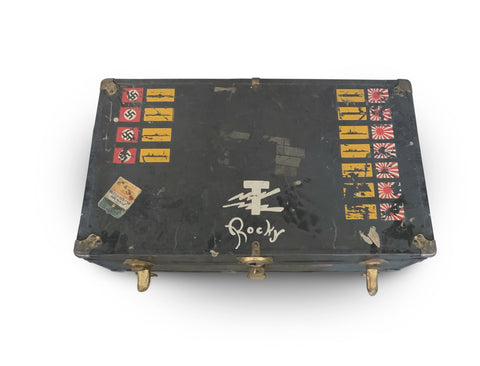
Is This the Winningest Footlocker of World War 2?
Q: I spotted this footlocker at a yard sale in Pahrump, Nevada. My dad, now 98, is a World War II vet and my wife is aVietnam vet, so we spent a lot of time talking about the footlocker and wondered if Rocky was still alive or what his story was. I’d like to return it to him or his family if possible; can you help me interpret its insignia?
—Phillip Berendsen, Pahrump, Nevada
A: This footlocker carries a startlingly impressive pan-ocean victory tally that includes both German and Japanese vessels. Not only were these enemy warships separated geographically, but they also ranged widely in type and size, from leviathan aircraft carriers and battlewagons to comparatively smaller destroyers and submarines. Could one man have had a hand in sending them all to the bottom?
Rocky, the presumed owner of the footlocker, was a U.S. Navy man. The lightning bolts above his name are nearly identical to those seen on the rating badges of sailors who specialized in radio and radar.
These unseen electromagnetic waves passing through the sky were critical to fighting at sea, giving ships and aircraft “eyes and ears” that extended far beyond the horizon. Radar could reveal an enemy submarine the moment it surfaced to recharge its batteries or uncover a gaggle of kamikaze aircraft headed toward the fleet. At that critical moment of discovery, navy communications specialists swung into action to put counterforces at the scene. Particularly late in the war, few enemies went unnoticed when they were within a battle fleet’s electronic reach.
The symbol “T” crossed by the bolts of lightning, though, is somewhat mysterious. There is no official specialty mark combining the icon and the letter. The “T” may stand for “technician” or “telegrapher”—perhaps a way Rocky unofficially separated himself from the more standard navy radioman. In the U.S. Navy’s alphabetical range of specialist letters, “T” also stands for “teacher.” Could Rocky have had a hand in instructing a generation of sailors how to detect and destroy seaborne threats?
It seems likely that the notable score affixed to this footlocker represents the work of more than one man, ship, or squadron. No single U.S. Navy unit can lay claim to assisting in the elimination of multiple Japanese carriers in the Pacific along with a number of German submarines in the Atlantic or Mediterranean. Even if our subject had the ability to transfer from ocean to ocean and somehow worked with aerial, surface, and undersea forces, the tally is astonishing for an individual. It makes more sense if it stands for the combined effort of many navy men plying their trade all over the globe.
And just who was Rocky, exactly? It is difficult to say. The name was quite rare in the 1920s, when our subject was most likely born. There is a better than average chance that Rocky was a nickname. His given name, the one that appeared on his draft card and navy enlistment papers, was probably something different.
—Cory Graff, Curator
Have a World War II artifact you can’t identify?
Write to Footlocker@historynet.com with the following:
— Your connection to the object and what you know about it.
— The object’s dimensions, in inches.
— Several high-resolution digital photos taken close up and from varying
angles.
— Pictures should be in color, and at least 300 dpi.
Unfortunately, we can’t respond to every query, nor can we appraise value.
this article first appeared in world war II magazine
Facebook @WorldWarIIMag | Twitter @WWIIMag
